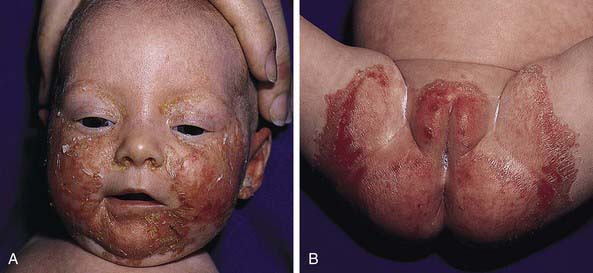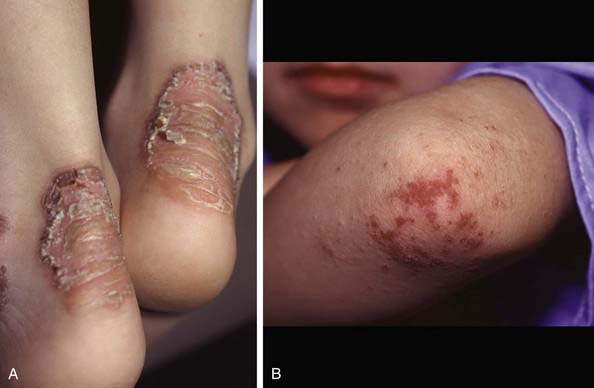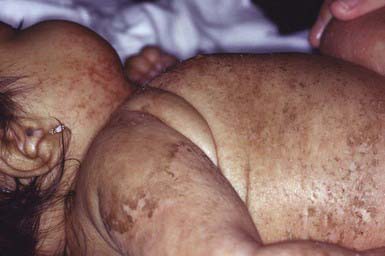Chapter 663 Nutritional Dermatoses
Acrodermatitis Enteropathica
Acrodermatitis enteropathica is a rare autosomal recessive disorder caused by an inability to absorb sufficient zinc from the diet. The genetic defect is in the intestinal zinc specific transporter gene SLC39A4. Initial signs and symptoms usually occur in the first few months of life, often after weaning from breast milk to cow’s milk. The cutaneous eruption consists of vesiculobullous, eczematous, dry, scaly, or psoriasiform skin lesions symmetrically distributed in the perioral, acral, and perineal areas (Fig. 663-1) and on the cheeks, knees, and elbows (Fig. 663-2). The hair often has a peculiar, reddish tint, and alopecia of some degree is characteristic. Ocular manifestations include photophobia, conjunctivitis, blepharitis, and corneal dystrophy detectable by slit-lamp examination. Associated manifestations include chronic diarrhea, stomatitis, glossitis, paronychia, nail dystrophy, growth retardation, irritability, delayed wound healing, intercurrent bacterial infections, and superinfection with Candida albicans. Lymphocyte function and free radical scavenging are impaired. Without treatment, the course is chronic and intermittent but often relentlessly progressive. When the disease is less severe, only growth retardation and delayed development may be apparent.
Kwashiorkor
Severe protein and essential amino acid deprivation in association with adequate caloric intake can lead to kwashiorkor, particularly at the time of weaning to a diet that consists primarily of corn, rice, or beans (Chapter 43). Diffuse fine reddish brown scaling (enamel/flaky paint sign) is the classic cutaneous finding. In severe cases, erosions and linear fissures develop (Fig. 663-3). Sun-exposed skin is relatively spared, as are the feet and dorsal aspects of the hands. Nails are thin and soft, and hair is sparse, thin, and depigmented, sometimes displaying a “flag sign” consisting of alternating light and dark bands that reflect alternating periods of adequate and inadequate nutrition. The cutaneous manifestations may closely resemble those of acrodermatitis enteropathica. The serum zinc level is often deficient, and in some cases, skin lesions of kwashiorkor heal more rapidly when zinc is applied topically.
Azevedo PM, Gavassone-Dias MF, Avelleira JC, et al. Acrodermatitis enteropathica in a full term breast-fed infant: case report and literature review. Int J Dermatol. 2008;47:1056-1057.
Heath ML, Sidbury R. Cutaneous manifestations of nutritional deficiency? Curr Opin Pediatr. 2006;18:417-422.
Leger D. Scurvy: reemergence of nutritional deficiencies. Can Fam Physician. 2008;54:1403-1406.
Marcason W. Can cutaneous application of vegetable oil prevent an essential fatty acid deficiency. J Am Diet Assoc. 2007;107:1262.









